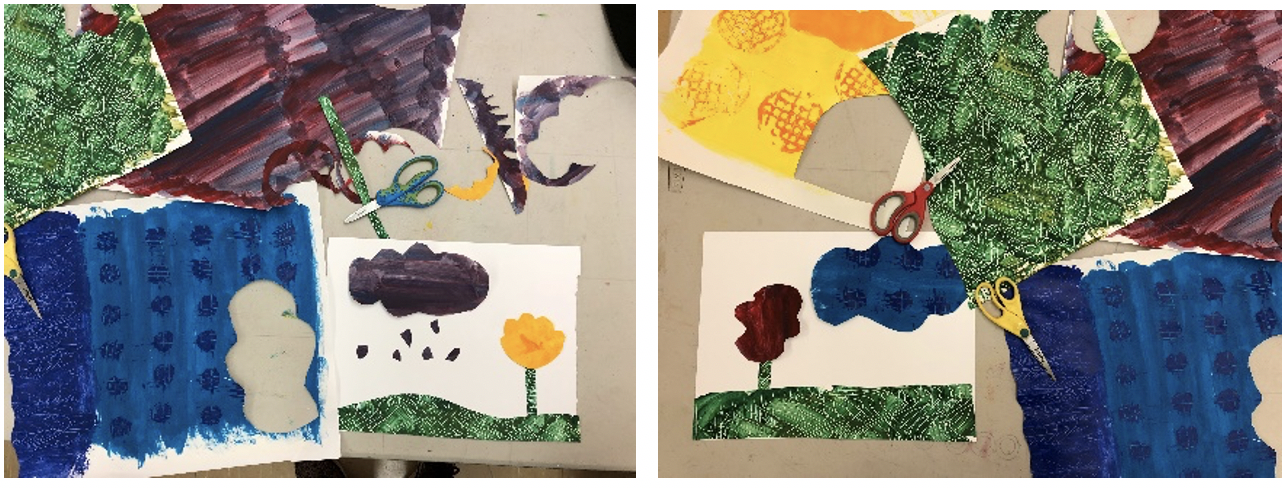Students will examine how a story is told using art without words then create collage papers to tell their own stories. Recommended for 1st Graders.
Color: What is perceived when waves of light strike the retina. Color is an element of art. Complementary Colors are the colors that are placed opposite one another on the color wheel.
Shape: A flat area, such as a circle or a square, that has clear boundaries.
Texture: The way a surface looks and feels, such as smooth, rough, or bumpy.
Pattern: Repeated colors, lines, shapes, or textures in an artwork.
Collage: Artwork made by gluing bits of paper, pictures, fabric, or other materials to a flat surface.
Story: An account or recital of an event or a series of events, either true or fictitious.
Storyteller: A teller of stories. An artist in the visual or verbal medium.
Creating textured papers:
Creating pictures:
Storytelling is basic to human existence. From the time there were people to communicate to each other stories have been told. Stories teach, inspire and entertain. Art is also basic to human existance. Art is how we express ourselves as a culture. All art tells a story. The visual artist has a message to communicate through images. We see this in cave paintings in Lascaux, France; in the pyramids in Egypt; in the galleries of art museums. Art appears in children’s picture books as well. Kids love this gentle introduction to art through a story.
Artists always have a story to tell. The Artist, Author and Illustrator, Eric Carle is well known for his ability to tell a story using images.
This is a two-visit lesson.
- Get multiple volunteers to help manage stations during first visit.
- Set up stations around the room for the various painting techniques. Here are some options:
- For more variety, these processes can be done on colored construction paper rather than plain white paper. Encourage students to not get caught up in details and to treat the painting of the papers purely as an abstract painting exercise. Some of the colors and patterns are to fill 18”x24” sheets from side to side, top to bottom. Other sheets can be divided in half with two color ideas on each half.
How does the art support the story? What choices did the artist make that help tell the story? Describe the textures you see and how they support the story.
Visual Thinking Strategies can help with this process. "What do you see? What else do you see? Why do you say that?" Ask students to point out evidence in the work to support their opinion and then "tell me more about that".
Did students analyze the work of Eric Carle? Were they able to describe how the works were made?
Did students exhibit skills and craftsmanship in executing their collage?
Visit 1: Creation of papers

Visit 2: Creating a collage which tells a story

Optional Phase 3:
Follow up with a writing, spoken or teacher-described prompt. Tell the story of their image.
Examples:

Lesson written by Angie Warren. Linda Wood, St. John's Lower School, Houston, Texas. Eric Carle. 1929-present. American illustrator and book author. "Glossary of Art Terms K-5” Cypress-Fairbanks Independent School District: Home. N.p., n.d. Web. 31 Mar. 2017.
21st Century Thinking Skills
Visualizing: Creating a mental image. Inferring: Driving meaning from clues, hints, evidence. (Art as Storytelling is using the pictures to determine or infer the meaning of the picture.)
WA State Learning Standards
(VA:Cr1.1.K) a. Engage in exploration and imaginative play with materials.
(VA:Cr1.2.K) a. Engage collaboratively in creative art-making in response to an artistic problem.
(VA:Cr2.3.K) a. Create art that represents natural and constructed environments.
(VA:Cr3.1.K) a. Explain the process of making art while creating.(Students are able to create a work of art and describe the art elements they use in their artwork such as color, line, shape or patterns.)
(VA:Re7.1.K) a. Identify uses of art within one’s personal environment. (Students use art as storytelling.)
(VA:Re7.2.2) a. Categorize images based on expressive properties.
(VA:Re8.1.K) a. Interpret art by identifying subject matter and describing relevant details. (Students use art as storytelling.)
Arts Integration Opportunities
Writing integration: have the children write a story based on their artwork.
Science integration: have the children learn two scientific facts about their animal and write a sentence about it.
Please note: These lesson plans are intended for non-profit use only. Use of these plans for commercial purposes should give attribution to the Issaquah Schools Foundation and be accompanied by a nominal donation at www.isfdn.org/donate. Thank you.
Fueling Success for Every Student, Every School